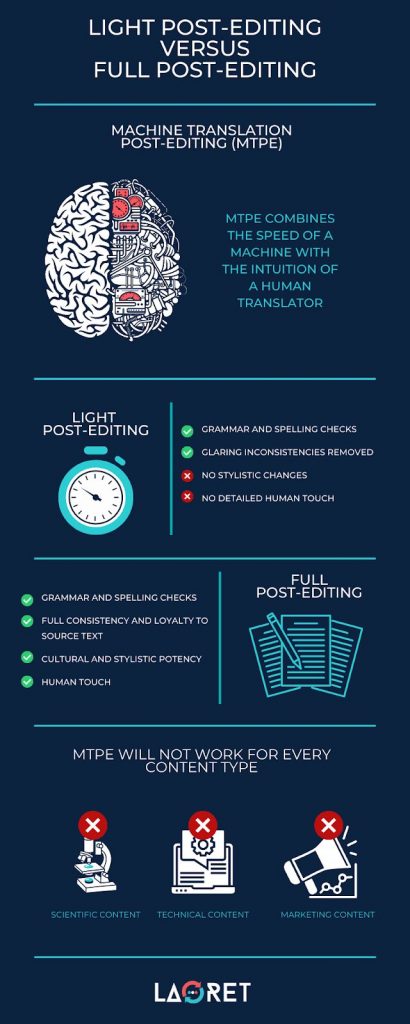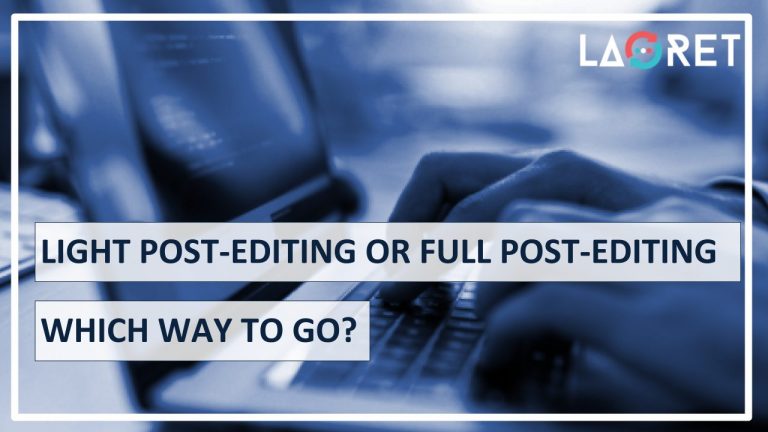Light Post-Editing Or Full Post-Editing: Which Way To Go?
Have you decided that you would like to request Machine Translation Post-Editing Services (MTPE), but are not sure whether your content should receive a light post-editing or a more thorough review? Don’t worry, it is true that there is not a lot of information out there that clearly defines the difference between light post-editing and full post-editing in a way that can help you make an informed decision.
But we are here to fix that! Read on and discover the ins and outs of each service, when you should apply them, and which goals are aligned with which strategy.
Machine Translation Post-Editing At A Glance
MTPE is a service designed to combine the speed of a Machine Translation (MT) Engine, with the expertise of a human translator. The content is run through an MT-Engine, and the output is edited by a human translator. Sounds ideal, right? But it is not that simple, and we will certainly get into this a bit later. But let’s first get down to the nuts and bolts of what this PE in MTPE actually does.
The output is subjected to a level of Post-Editing that can be either “light†or “fullâ€. In order to obtain a similar quality to that of a top-of-the-shelf human translation, full-post editing is highly recommended. Light post-editing, on the other hand, will provide you with a passable translation that is recommended when the end results fit a purpose where comprehension is needed, but top quality is not the ultimate goal.
Pro Tip! There is a lot involved in the MTPE-Process such as preparing your content for translation and performing targeted training and testing. But don’t worry, we explain everything into detail in our blog on how MTPE is best executed!
However, we have noticed that for our clients, it is not always as simple as choosing either light or full, especially since MTPE is known as the service that gets you good results for a friendly price and a quick turnaround. Additionally, selecting either light or full editing is not always as straightforward as it may seem.
So, let’s dig a little deeper into the purpose and application of each service and help you make an informed decision for your next project!
Light Post-Editing: Ideal For Internal Communications
MT followed by light post-editing, is designed to weed out any major issues and resolve glaring ambiguous phrases.
However, no stylistic changes will be administered. The translation, while understandable and carrying the correct meaning, might still feel like a literal interpretation of the source text. This means that the translation will not be a good representation of your brand since the tone and style you have worked to create, will not be included in this service.
So, while light post-editing will deliver you with the most cost-effective option of the two, the source content’s meaning will not be conveyed in a way that can connect with your target audience.
For this reason, light post-editing should be utilized exclusively for:
- Usage within the company itself (think chat logs and basic international communications)
- When the content is short and you have to follow a very strict deadline, but the content will not carry much weight from a marketing perspective
- Content that has a lower priority in the translation tier such as reference materials
- Basically, content that will not be published and visible to clients unless these include less-visited pages without crucial information (although we still don’t recommend this)
We may have presented light post-editing as a service with a singular application, but we would like to stress that the ideal choice of service will largely depend on the raw output of the MT. Any translation will be checked before the ideal service and linguist is assigned to it. So, if the output turns out to be of good quality, light post-editing could still be the correct service to go for.
Pro Tip! Did you know that you can influence the output quality greatly by choosing the correct engine for your language pairs? Have a look at our blog about Which Machine Translation Engine Works Best For Your Content and learn all about it!
In order to avoid confusion, we recommend that you consult your Language Service Provider (LSP) before making any decisions. Share with them specific information about the purpose you have with this content and allow them time to review the output so you will invest in the most suitable service aligned with your goals.

Full Post-Editing: The Machine Meets The Human Touch
So, if light post-editing provides clarity without any stylistic tweaks, what does full post-editing do? Full post-editing is a more in-depth editing process where the linguist aims to provide a completely accurate translation that communicates with the tone, style, and pre-approved terminology. There will be no inconsistencies in the text and the language will feel completely natural.
The full post-editing process includes the light-editing tasks of grammar and spelling checks, but also includes:
- Confirming the terminology usage and checking that it conforms with the approved master-list provided by the client
- Provide syntactical alterations where need be so the language flows naturally
- Making sure the translated content is stylistically consistent
- Including cultural references and idioms where need be
- Checking the content for any sensitive material that could be misinterpreted in the target locale.
- Confirming a strict loyalty to the source message
- Applying the correct format
Even With Full Post-Editing, Not Every Content-Type Could Benefit From MTPE
In essence, a full post-editing service has to meet the same quality expectations as a full human translation. This may sound like a pretty ambitious goal, which it is.
That is why we would like to make a point of saying that not every content type will benefit from MTPE, whether it is subjected to the light or full process. Because while MTPE is gaining interest, it is key to keep the User Experience and content goals in mind when planning your strategy.
If your content involves highly technical materials with a lot of nuances, scientific materials that require complete accuracy, or marketing content that needs to establish a genuine connection with your audience, MTPE is not the service for you. Content with a sensitive streak will need to be rebuilt completely once run through an MT-Engine, so it will actually take more time and resources to edit than output than to allow a linguist to translate the content from scratch.
Of course, there are further nuances. Have a look at this graph we designed for eCommerce Content and which translation method works best for which content type. This will give you a better idea of which specific content will require more TLC, and which ones can benefit from MT & MTPE. And remember, your LSP is trained in assigning the best service for each project, so take their advice to heart!

Conclusion
The choice on whether to go for light post-editing or full post-editing, even on whether to select MTPE at all, will fully depend on your content goals & strategies. Do you have files and documents that you need translated for internal communication? Then light post-editing will be your best bet. Do you need human quality or does your content need to be exported and presented to clients? Then you will need full post-editing. Of course, it is not always so black and white. For example, do you have complex content with a lot of nuances or are your goals marketing-oriented? Then you should opt for human translation. When in doubt, talk to your LSP! They will provide clarity.
At Laoret, we are fully equipped to deliver top quality MTPE Solutions through our technological authority and translators highly-trained in the Post-Editing Process. We are open with our clients when it comes to which methods would suit their machine translation goals and their target audience’s needs. So, will always aim to offer the best service for each client and each content goal.






